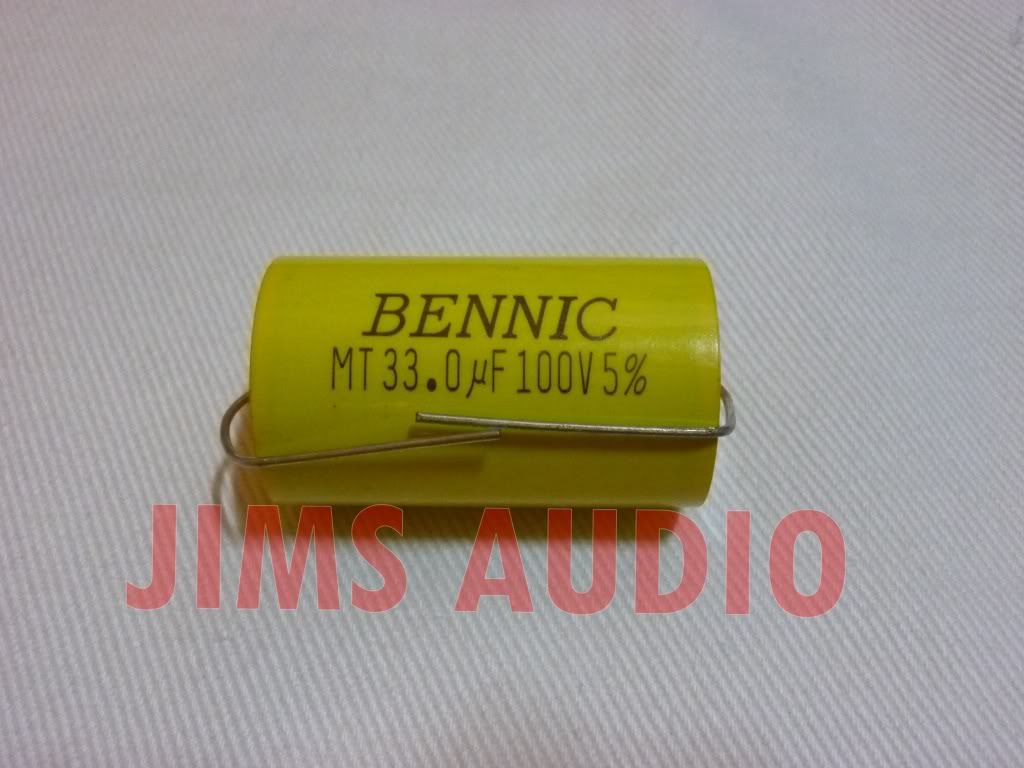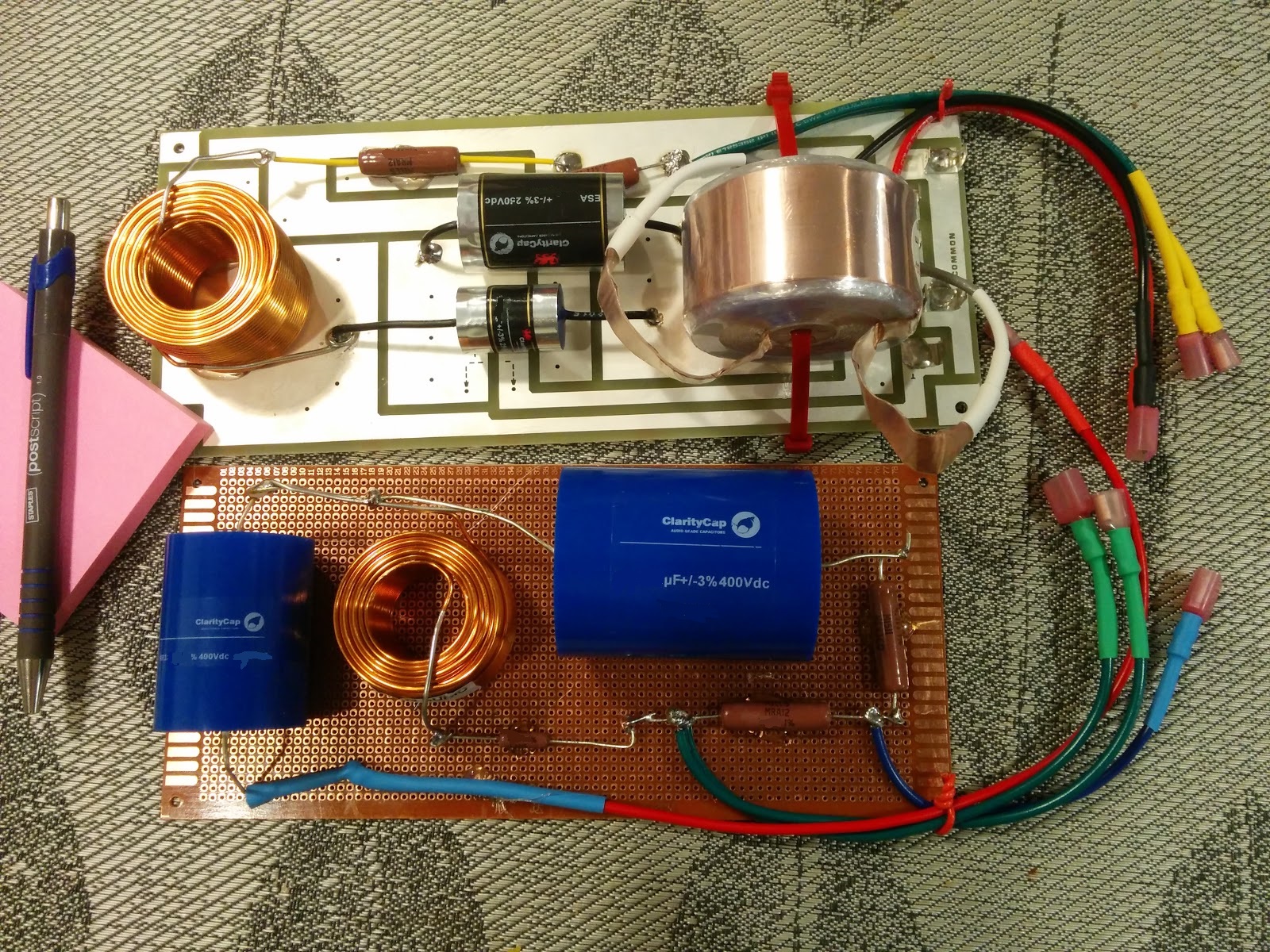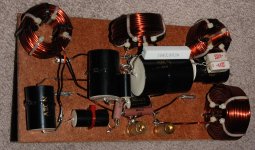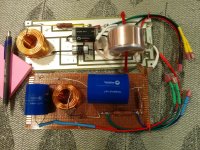Googling for martin logan upgrade I can across post describing how the 33uF electrolytic capacitor is replaced - reason being at the time - mid 90s, such large value film capacitors were not available.
I also note that there are two other capacitors 100uF and 180uF that appear to be electrolytic so I would expect the same can be done with them.... if such high values exist.
There are different types of film capacitor, other than price, what is the difference between a MKT film (as below) and the more expensive coaxial lead, shown below below.
and coaxial lead type:

I also note that there are two other capacitors 100uF and 180uF that appear to be electrolytic so I would expect the same can be done with them.... if such high values exist.
There are different types of film capacitor, other than price, what is the difference between a MKT film (as below) and the more expensive coaxial lead, shown below below.
An externally hosted image should be here but it was not working when we last tested it.
and coaxial lead type:

So one bit of advice before anything else. Usually in speakers, anything over 100V is fine. Electrostatic speakers are the big exception to this rule due to the very high DC charge voltages found.
Please note voltage ratings of original parts carefully and do not go below the original spec. Also, the higher the voltage the more distance you must keep the leads apart to avoid accidental arcing. Lastly, make sure the speakers have discharged fully before attempting to work on them. Caps may store lethal voltage for hours. This only applies to you working in electrostatic speakers.
As for film cap uF values, they can be built up. So you can easily make a 33uF cap out of several others in parallel. In fact, anything over 10 uF I suggest you do in fact use parallel construction, especially if in series with the signal.
Axon is a high value/low cost version of Solen/SCR. Very useful for large cap values in parallel parts of the circuit, but only available in 250V as far as I know. Solen has caps in the 47uF range. My only source in the US of those is partsconnexion.com. In the EU, Audiohobby.eu usually has many parts to choose from at good prices.
Best,
Erik
In series, my starter suggestion is the Mundorf MKP line. Lots of low level detail after the first 24-48 hours of playing. Underrated and among the boutique caps a bargain around $7 for 10uF.
Please note voltage ratings of original parts carefully and do not go below the original spec. Also, the higher the voltage the more distance you must keep the leads apart to avoid accidental arcing. Lastly, make sure the speakers have discharged fully before attempting to work on them. Caps may store lethal voltage for hours. This only applies to you working in electrostatic speakers.
As for film cap uF values, they can be built up. So you can easily make a 33uF cap out of several others in parallel. In fact, anything over 10 uF I suggest you do in fact use parallel construction, especially if in series with the signal.
Axon is a high value/low cost version of Solen/SCR. Very useful for large cap values in parallel parts of the circuit, but only available in 250V as far as I know. Solen has caps in the 47uF range. My only source in the US of those is partsconnexion.com. In the EU, Audiohobby.eu usually has many parts to choose from at good prices.
Best,
Erik
In series, my starter suggestion is the Mundorf MKP line. Lots of low level detail after the first 24-48 hours of playing. Underrated and among the boutique caps a bargain around $7 for 10uF.
Last edited:
Bennic MT series capacitors are Metallized Polyester (MKT) type, non-inductive.
On the first photo is no-name MKT, which maybe is not non-inductive, hence the cheaper price.
On the first photo is no-name MKT, which maybe is not non-inductive, hence the cheaper price.
MKT = Metallised polyester film
MKP = Metallised polypropylene film
Both are metallised film types. Taken purely independently, both should be superior to an equally well designed electrolytic. That's taking them independently though. Be careful assuming that you can simply substitute an MKT, MKP, PIO (paper in oil) or film & foil (separate film & foil layers) for an electrolytic capacitor. In most competently designed speakers, which like them or not Martin Logans certainly are, the ESR of an electrolytic cap may have been accounted for in the crossover design & have an effect on the transfer function. Change that, and you're changing the crossover behaviour, more or less subtly depending on specific application.
MKP = Metallised polypropylene film
Both are metallised film types. Taken purely independently, both should be superior to an equally well designed electrolytic. That's taking them independently though. Be careful assuming that you can simply substitute an MKT, MKP, PIO (paper in oil) or film & foil (separate film & foil layers) for an electrolytic capacitor. In most competently designed speakers, which like them or not Martin Logans certainly are, the ESR of an electrolytic cap may have been accounted for in the crossover design & have an effect on the transfer function. Change that, and you're changing the crossover behaviour, more or less subtly depending on specific application.
Last edited:
MKT = Metallised polyester film
MKP = Metallised polypropylene film
Both are metallised film types. Taken purely independently, both should be superior to an equally well designed electrolytic. That's taking them independently though. Be careful assuming that you can simply substitute an MKT, MKP, PIO (paper in oil) or film & foil (separate film & foil layers) for an electrolytic capacitor. In most competently designed speakers, which like them or not Martin Logans certainly are, the ESR of an electrolytic cap may have been accounted for in the crossover design & have an effect on the transfer function. Change that, and you're changing the crossover behaviour, more or less subtly depending on specific application.
MKT and PIO are probably the closest to NPE/lytic ESR performance.
No worries, as that cap is before the audio-step up transformer (and not part of the DC HV supply).So one bit of advice before anything else. Usually in speakers, anything over 100V is fine. Electrostatic speakers are the big exception to this rule due to the very high DC charge voltages found.
deccimal point placed wrong
I smell something fishy here.
I think the decimal point is placed wrong in the caps shown in the picks.
They look more like 0.47 and 0.33 to me judging by size.
Measure and confirm with a capacitance meter or compare with known caps of same value using X100 scale of a analog multimeter.
I have yet to see 33uF and 47uf caps in crossovers other than in subs and the Yamaha NS 10000.
I smell something fishy here.
I think the decimal point is placed wrong in the caps shown in the picks.
They look more like 0.47 and 0.33 to me judging by size.
Measure and confirm with a capacitance meter or compare with known caps of same value using X100 scale of a analog multimeter.
I have yet to see 33uF and 47uf caps in crossovers other than in subs and the Yamaha NS 10000.
I smell something fishy here.
I think the decimal point is placed wrong in the caps shown in the picks.
.
maybe the font used is larger?
I'm pretty sure they are correct - the rectangular capacitor can be obtained in even larger (but not by much) then 33 uF.
try claritycap, wonderfull😉maybe the font used is larger?
I'm pretty sure they are correct - the rectangular capacitor can be obtained in even larger (but not by much) then 33 uF.
First one looks like a Visaton MKT. Terrible sound, both from the polyester and polypropylene series. Their leads also tend to break after a few desolder/soldering, same for their MOX resistors which also sound crap. I didn`t believe in capacitor sound until I tried the Visaton MKP which was horrible. I would second the recommendation for Clarity Cap, very nice capacitors ( have used only the PX range ). Jantzen Cross-caps are also a good option.
Last edited:
Clarity Caps are in fact very very good. 🙂 They are open and transparent without the Disney-like sheen of the high-end Mundorfs. They are rather high ESR, and I did benefit from bypassing a large one with Audyn True Copper caps. Had I had the forsight I would have bought smaller caps and put them in parallel.

Attachments
If you have high ESR bypass wont change a thing, more likely speed. I like clarity cap, if you want to improve the sound solder all leads: I see crimp connectors !
Every now and then a person comes across a truly bad capacitor, but I think it is rare. Most are more similar than not. One that stood out was an MKT of similar size to this which I tried in both an amp and a speaker before just disposing of it. On the other hand some of the best I have are FK/MKP. This was more than a dielectric material issue.MKT. Terrible sound,
I find the Clarity caps to be fairly neutral, which let's me move on to other things.
If you have high ESR bypass wont change a thing, more likely speed. I like clarity cap, if you want to improve the sound solder all leads: I see crimp connectors !
None of that aligns with my experience, I'm sorry.
XSim and my ears both agreed that bypassing the largest cap made an important difference. However, bypassing the small blue cap did nothing.
I heard the diff first, then examined the XSim model, by the way.
Yes, you see crimp connectors. Don't use them if you don't like them, I've only had problems when the crimps were bad.
By the way, that little black cap you see is a Duelund silver foil bypass cap.
Best,
Erik
erik!, you took the words out of my mouth😀Clarity Caps are in fact very very good. 🙂 They are open and transparent without the Disney-like sheen of the high-end Mundorfs. They are rather high ESR....
my friend had mundorf on tw and he listen with the grills, despite this the listenings were too sheen, unnatural.
so since i have all crossover with claritycap MR and ESA, i suggest him to chenge only tw caps with ESA 630V.
well, he is still thanking me now😉
he say that now the sound is more open, natural and transparent without the emphasis and compression of mundorfs compared, in fact now he is able to listen also without the grills if he want.
in the past i also used mundorf in many of my project, but when i tried claritycap never came back😉
erik!, you took the words out of my mouth😀
my friend had mundorf on tw and he listen with the grills, despite this the listenings were too sheen, unnatural.
so since i have all crossover with claritycap MR and ESA, i suggest him to chenge only tw caps with ESA 630V.
well, he is still thanking me now😉
he say that now the sound is more open, natural and transparent without the emphasis and compression of mundorfs compared, in fact now he is able to listen also without the grills if he want.
in the past i also used mundorf in many of my project, but when i tried claritycap never came back😉
Diy, I've not used the ESA's in the tweeter yet, but will for the LM-1 crossovers.
I actually prefer the Mundorf MKP to the Silver/Oil's and variants for the reasons we've discussed. The MKP's have a lot of low level detail and IMHO are underrated, especially for the price! 🙂 Honestly I'd rather pay $7 for a fantastic cap than $70.
I heard Magico speakers at their listening room and I am really glad I did! They use all Mundorf Silver/Oil and I was debating to use them or Clarity. It was no contest to me, but many others were wowed by it.
I think some of this may have to do with how the crossovers and tweeters are matched. My choice in crossover design and tweeters is to use a gently descending slope that is flat past 20 kHz. Many makers prefer to take a nose dive in response at the top octave, but even then, there's some weird "sparkle" left over in the Mundorfs. To each their own, but my current balance in crossover design, tweeters and capacitors sounds much more natural, open, versatile and enjoyable to me.
Best,
Erik
Last edited:
- Status
- Not open for further replies.
- Home
- Loudspeakers
- Multi-Way
- Crossover capacitors

